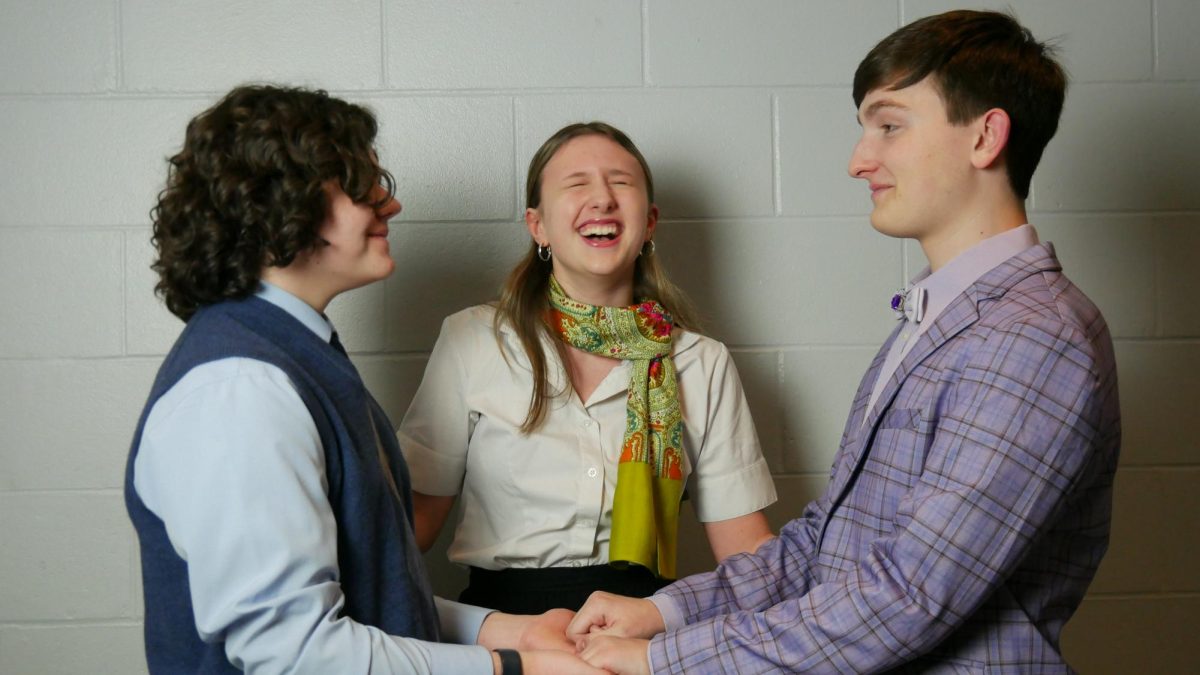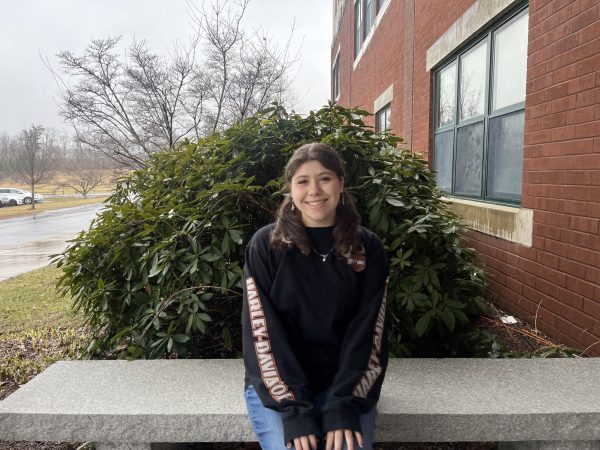Audiences in the HB Community Auditorium this week will be blasted into the past to experience the tale of three lifelong friends who share a dream. However, the story comes with a major twist– reverse chronology. This year, the HBHS Theatre Department stages a whopping five performances of their spring musical, Merrily We Roll Along, on March 15, 16, 21, 22, and 23.
Merrily We Roll Along, which is also currently running on broadway, tells “a story of the painful architecture of long-term friendship,” says Peter Marks of the Washington Post. The show opens with 40 year-old Franklin Shepard, a big shot whose life and friendships soon fall apart. Afterward, the ensemble turns the clock back a few years at a time to reveal how Frank’s choices led to the fallout in the first scene. The audience sees how Frank, Mary and Charley’s dreams evolve over the course of about 20 years, starting in 1976 and ending in 1957. “You travel backwards, so the final scene is the friends meeting for the first time and having these ideas and these dreams,” says director Dylan Silcox. Ideally, the audience will take away some hope from this show, and continue pursuing their own dreams.
The HB production stars Colby Hallett ‘25 as musical composer Franklin Shepard, Jakob Kolb ‘27 as lyricist Charles Kringas, and Emma DiGennaro ‘25 as author and critic Mary Flynn. Portraying the three friends has proved quite easy for the trio. “We just clicked when we started working together,” says DiGennaro. Such closeness is vital to the show’s success.
However, it’s definitely not all fun and games. As Kolb puts it, “we still get work done, but we enjoy it.“ Their ability to balance work and play will surely help bring the show to life. Hallett feels their trio is perfectly suited: “I don’t see anyone else being cast as Mary and Charley,” he says.
Merrily’s reverse-chronological structure can make it difficult to fully comprehend. Kolb, who has seen the show on Broadway, states he initially “didn’t take away what [he] know[s] now.” Such an intimate understanding of the show is a result of the hard work all of the cast and crew put in. In fact, Silcox suggests that audiences watch it more than once. “You get to watch it the first time and you see the whole story unfold backwards, and then you watch it again with the context of how they start, and you start to pick up on the small little things.”
Merrily is notorious for being famed composer Stephen Sondheim’s biggest flop, closing less than 2 weeks after its opening at the Alvin Theatre on Nov 16, 1981. A major criticism of the original production was less about the music, but rather the story itself. In his review of Merrily’s opening performance, Frank Rich of the New York Times writes, “Mr. Sondheim has given this evening a half-dozen songs that are crushing and beautiful – that soar and linger and hurt. But the show that contains them is [in] shambles.” Merrily has since undergone intense revisions which helped to keep the story together.
Despite the story’s faults, most sources seem to agree that the score is quite impressive. “This is one of those Sondheim listening occasions when you think, ‘No, this one is his strongest score,’” writes Marks. Sondheim’s other works include Into The Woods, Sweeney Todd, and West Side Story, which are easily recognizable as his. “Sondheim…famously writes very distinct music,” says Mr. Charles Rogers, the show’s musical director and HBHS band teacher. Merrily’s score is no different. Songs like ‘Opening Doors’ are intended to help audiences’ understanding of the show as it moves backwards in time. “Opening doors…is important because it’s towards the end of the play, but the beginning of the story, and it’s kinda talking about…how open-ended and exciting the world seems when …you haven’t made all the mistakes yet,” says Rogers.
The HB Community Auditorium is home to all three of the department’s shows throughout the season. Participating students feel positively about their experiences: “I love that everyone supports each other,” says DiGennaro. Hallett states that he also loves the people, before continuing, “I’ve tried a lot of other things…acting and theatre and musicals, that’s where I love to be.” This tight-knit dynamic carries over into the show. For instance, ensemble roles require a ton of teamwork. “The ensemble is not just ensemble. Every single actor… has a character who has their own backstory and a reason for…joining what is called ‘The Blob’ onstage,” says Silcox.
Inevitably, audiences will question the true meaning of the show. “You gotta…stop and smell the roses, that’s the big thing,” says Kolb. His statement applies both to the story and to everyone involved in the production, as he feels rehearsals have gone by quickly. In terms of Merrily’s plot, it’s a reminder to hold onto the things that you care about most.
Over the course of two hours, audiences see how Frank’s choices lead him further and further from happiness. “It’s a sad story if you’re looking at it that way,” says Silcox. However, not all hope is lost. “At the end, that’s where you are. That’s where the cast is, that’s where the audience is. We’re all starting there. We’re all having our dreams,” he states.
Merrily’s Broadway revival has recently extended its run! While initially projected to close March 24, performances will now run through July 7. The revival stars Jonathan Groff as Frank, Daniel Radcliffe as Charley, and Lindsay Mendez as Mary, among many other talented folks.
In the words of DiGennaro, Merrily’s message rings clear: “There is hope for our futures and we should follow our dreams, no matter where they may take us.”





![Students perform one of the plays from the 24-Hour Play Festival. The actors had less than 12 hours to fully learn the script and prepare for the performance. “[The actors] had to memorize it in a day and also make it their own in a short amount of time,” said Toner. (Courtesy Adrienne Rosenblatt)](https://cavchronline.com/wp-content/uploads/2025/01/24-Hour-play.jpg)

